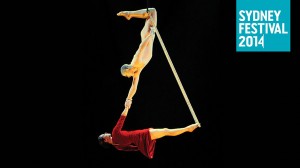Ockham’s Razor | Sydney Festival & Seymour Centre
- January 26th, 2014
- Posted in Uncategorized
- Write comment

There is something very satisfying or attractive about the notion of simplicity. Ockham’s Razor is a theory which privileges simplicity with the notion that “among competing hypotheses, the hypothesis with the fewest assumptions should be selected.” The thinking goes on to suggest that simplicity is natural. (I’ll cite Wikipedia here)
“Prior to the 20th century, it was a commonly held belief that nature itself was simple and that simpler hypotheses about nature were thus more likely to be true. This notion was deeply rooted in the aesthetic value simplicity holds for human thought and the justifications presented for it often drew from theology. Thomas Aquinas made this argument in the 13th century, writing, “If a thing can be done adequately by means of one, it is superfluous to do it by means of several; for we observe that nature does not employ two instruments [if] one suffices.””
Modesty, efficiency, clarity.
All worthwhile pursuits in thinking. And worth pursuing in art. The history of art is complex enough… without adding more tangles and flourishes to it. The simple problem for the aerial artist (also the one that defines the craft) is gravity. A simple but heavy solution, no?
A fan of Peter Brook’s The Empty Space and Grotowski’s Towards a Poor Theatre – how could I not love the philosophy behind this innovative company.
And surprisingly refreshing is the modest and ordinary everyday costumes – not designed in glitter to show off gleaming abdominal muscles… but simple clothes. Simple stories. Actions and reactions. Simple exchanges and shifts in weight.
Written for www.australianstage.com.au
Suspended on a grid of metal pipe, sits three people. Two women and a man. Somehow caught adrift in mid-air the three stare into the dark of the audience. At any moment they might speak, or sing – to us, to each other. Instead an intricate balance of interweaving, playful exchanges, urgent competition and bitter rivalry erupts. This is Arc – the first in a triple bill by Ockham’s Razor.
Directed by Ruth Naylor-Smith with music composition by Derek Nisbet, this is not merely a series of tricks and flourishes, but a very tender piece of visual storytelling centred around the uncertainty and tenuousness of a love triangle.
The second piece Memento Mori is inspired by Holbein’s “The Dance of Death.” Here, a thrilling seduction by Death, romances a woman in red swinging on a trapeze frame. This piece in particular seems a little outside the focus on aerial theatre – the premise simple, the action clear and so without too much of a conflict or struggle – this appears to be more of a short portrait than a story – but Ockham’s Razor being as it is, simplicity is sometimes best.
Third in the triple bill is Every Action… a playful story filled with problems, surprises, solutions and small satisfactions. Four people find a rope and then find fun in climbing, competing, swinging and pulling each other in and out of various rope formations. A more playful piece, Every Action… is a joyful exploration of gravity and our dependence on each other for equilibrium.
Taking their name from a medieval Ockham’s Razor is a principal which states that when given a choice between two theories, the simplest should always be selected. It is also a critically acclaimed aerial theatre company “specialising in creating arresting, entertaining and unconventional theatre on new pieces of aerial equipment.” Two of the artistic directors (Alex Harvey and Charlotte Mooney) perform alongside guests Grania Pickard and Steve Ryan across the suite of three short works.
The total effect of the triple bill is more of that of a sample of situations or ideas – not quite a curated or considered over-arching visual theme or aesthetic – though the philosophy of the company delivers consistent messages of connectedness, fragility, strength and adaptability. This is not a show whereby actions are completed with the expectations of applause, more that each action fluidly moves from one moment to another to convey story or shifts in emotion. The overall effect is mesmerizing and entertaining.
The delight comes from the focus of the performers on each other and the diversity of situations and equipment in the works, and challenges the well worn path of circuses – that of spectacle for it’s own sake. Relationships between performers is intense, intergral and carries with it a message of trust, vulnerability and interconnectedness. Such a message is made strikingly powerful when the stakes are raised – and without a net – nor harnesses on the bodies of the performers.